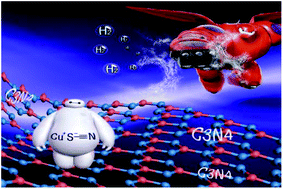Interfacial N–Cu–S coordination mode of CuSCN/C3N4 with enhanced electrocatalytic activity for hydrogen evolution†
Abstract
Nitrogen/carbon layer coordinated transition metal complexes are the most important alternatives to improve the catalytic performance of catalysts for energy storage and conversion systems, which require systematic investigation and improvement. The coordination mode of transition metal ions can directly affect the catalytic performance of catalysts. Herein, this paper reports that two kinds of Cu-based composites (CuSCN and CuSCN/C3N4) are prepared by in situ controllable crystallization of copper foam (CF) through electropolymerization and calcination. As a comparison, it is clarified that the different coordination modes of Cu1+ ions determine the different catalytic properties. The samples can be switched freely by tuning the electropolymerization period, which leads to different coordination modes of Cu1+ ions dramatically, thus affecting the electrocatalytic performance of composite materials for the hydrogen evolution reaction (HER) in turn. Thorough characterization using techniques, including X-ray photoelectron spectroscopy (XPS) and synchrotron-based near edge X-ray absorption fine structure (EXAFS) spectroscopy, reveals that strong interactions between CuSCN and C3N4 of CuSCN/C3N4 facilitate the formation of subtle coordinated N–Cu–S species, of which electronic structures are changed. Density Functional Theory (DFT) calculations indicate that the electrons can penetrate from CuSCN to N atoms present in C3N4. As a result, CuSCN/C3N4 demonstrates a better catalytic performance than the conventional transition-metal-based electrocatalysts. Besides, CuSCN/C3N4 reflects almost identical hydrogen evolution reaction (HER) activity and stability in an acid electrolyte with Pt/C.



 Please wait while we load your content...
Please wait while we load your content...